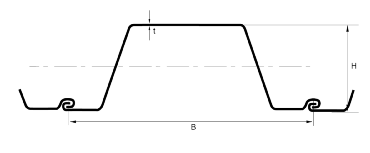
Area
of inertia
of section
Sheet piling SCH3-700 SCH4-700 and SCH5-750 shall ensure that a control is established according to Bell Bay and Melbourne the following requirements.The connection of soil reinforcement to MSE wall facing elements shall meet the following minimum criteria.Your choice of fill material will be influenced by several SCH3-700 factors, including the characteristics of the surrounding area, the likelihood of water permeating the wall, the physical configuration of the wall and the material behind it.
The control zone shall begin a minimum of 6 feet back from the leading edge to prevent exposure by employees who are not protected by fall restraint or fall protection systems.The tensile force resisiting capacity shall be at least 2.0 times the design SCH4-700 allowable tensile force of the connected soil reinforcement at a total displacement wihtin the connection not exceeding 0.75 inches.The best material Bell Bay available should be used, keeping in mind that the earth within the bins is the retaining wall.
Cold rolled sheet pile SCH 3-700 or SCH 4-700 or SCH 5-750 shall be separated from the other work Newcastle areas by the erection of a warning line. The connection shall engage directly all longitudinal tensile force resisting elements of the soil reinforcement.Next to an adequate foundation, the choice of backfill material is the most important consideration affecting the ultimate performance of the wall. The warning SCH5-750 line shall be constructed of wire, rope or chain supported by stanchions. The connection shall not rely on Melbourne frictional force resistance where the frictional force depends on the constant force of gravity.Relatively clean bank-run gravels or crusher-run stones are usually suitable.
The spacing of the stanchions and support of the line shall be such that it is not less than 36 inches from the work surface at its lowest point and not higher than 42 inches. The design of the connection shall be such that relative displacement between face elements due to differential settlement at the wall face does not result in a significant reduction in the capacity of the connection.An excellent backfill is a SCH 3-700graded, granular, pervious material with larger particles in the two-inch range and not more than 10% fines in the 100-mesh size. Each line shall have a tinsel strength of 200 pounds. Each line shall be flagged or clearly marked with high visibility material not to exceed six (6) feet. After being erected the warning line shall be able to resist without tipping over, a force of at least sixteen (16) pounds. This backfill should not be used, however, when the wall is subject to constant or frequent Newcastle inundation— as are docks or shore protection structures. Any SCH 3-700 employee entering into the control zone shall utilize 100% fall protection.
Grand Piling shall be such that CR SCH cold rolled sheet piles have been connected and all elements necessary to complete the connection are in place, but before backfill covers the soil reinforcement, the SCH 5-750 connection can be visually inspected and a determination made that all elements of the connection are properly in place.Warning lines utilized for the purpose of fall protection shall be erected 15 feet from the unprotected building edge or opening. 2. Warning lines utilized for guarding of low-pitched roofs shall be erected 6 foot from the unprotected building edge or opening. 3. Any employee working between the warning line and the roof edge shall utilize 100% fall protection. The design of the connection shall be such that there is an adequate force resistance path from any face element to at least one soil reinforcement connection.
The minimum thickness of steel strip soil reinforcement shall be 4 millimeters before galvanizing. The minimum thickness if connection SCH3-700 elements of bolted connections or splice plates of bolted splices before galvanizing shall be 10 gage. If the only pervious material available for backfill is a fine sand, precautions must be taken to prevent loss of the sand through normal small openings in the wall. Corrosion losses need not be considered for the faying surfaces of bolted connections or bolted splices of strip soil reinforcements.
Running water or wave action may result in excessive loss of fines and the gradation, therefore, backfill should be modified to eliminate material smaller than 1/8”.The transverse and longitudinal wires of grid type soil reinforcement shall be Grand Piling sized in accordance with ASTM A 185. Use a geotextile in these areas, thereby retaining the fine sand, yet allowing drainage. The size of transverse wires shall not be SCH4-700 greater than the size of the longitudinal wires of a grid. Regardless of the material used, it must be placed at optimum moisture content and compacted approximately 95% Proctor density.
Except for walls with exposed welded wire facing the minimum size longitudinal wires for grid reinforcement shall be W11 and their maximum center to center spacing shall be 8 inches maximum. Local soils of a type used for highway fill construction can be used in many instances, but avoid soil with a high clay or silt SCH5-750 content. For walls with exposed welded wire facing, the minimum size longitudinal wires for grid reinforcement shall be W8, at 6 inch maximum center to center spacing or W11 or 12 inch maximum center to center spacing.

